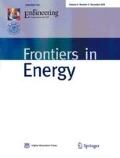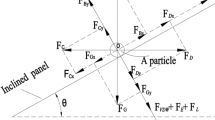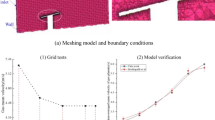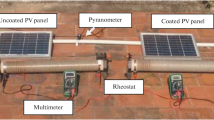Abstract
Solar energy is one of the most promising forms of renewable energy for solving the energy crisis and environmental problems. Dust deposition on photovoltaic mirrors has a serious negative impact on the photoelectric conversion efficiency of solar power stations. In this paper, the influence mechanism of the dynamic and static liquid bridge forces on particle deposition behaviors on solar photovoltaic mirrors is investigated. In addition, the expression and physical meaning of the particle critical separation velocity are proposed. The research results show that the static liquid bridge force can be the primary deposition force causing dust particles to adhere to photovoltaic mirrors. However, the dynamic liquid bridge force can act as a resistance force for the particle motion process and even make dust particles roll along and finally stay on the mirror. The contact force is the primary separation force that causes dust particles to flow away from the mirror. Whether dust particles adhere to the mirror depends on the relative size of the deposition and separating forces. The particle critical separation velocity describes the relative size of the collision-rebound effect and mirror adhesion effect and is expressed in Eq. (16). These research findings can provide theoretical guidance for mirror cleaning methods in the operation process of photovoltaic mirrors.
Similar content being viewed by others
Abbreviations
- \(\overline{\omega}\) :
-
Lifshitz constant
- l 0 :
-
Average distance between molecules/m
- α :
-
Particle incident angle/(°)
- θ :
-
Mirror installing angle/(°)
- θ 1 :
-
Solid-liquid contact angle/(°)
- g :
-
Gravitational acceleration component/(m·s−2)
- μ l :
-
Dynamic viscosity/(kg·(m·s)−1)
- μ t :
-
Turbulent viscosity/(kg·(m·s)−1)
- μ s :
-
Friction coefficient
- k n :
-
Spring constant in normal direction/(N·m−1)
- k t :
-
Spring constant in tangential direction/(N·m−1)
- u c :
-
Particle critical separation velocity/(m·s−1)
- u 0 :
-
Particle inlet velocity/(m·s−1)
- v r,n :
-
Normal relative velocity/(m·s−1)
- v r,t :
-
Tangential relative velocity/(m·s−1)
- R*:
-
Equivalent radius/m
- δ n :
-
Normal displacement/m
- δ t :
-
Tangential displacement/m
- c n :
-
Damping coefficient in normal direction/(N·s·m−1)
- c t :
-
Damping coefficient in tangential direction/(N·s·m−1)
- F v :
-
van der Waals force/N
- F l :
-
Liquid bridge force/N
- F l,d :
-
Dynamic liquid bridge force/N
- F l,dn :
-
Normal viscous component of Fl,d/N
- F l,dt :
-
Tangential viscous component of Fl,d/N
- F l,s :
-
Static liquid bridge force/N
- F g :
-
Gravity force/N
- F e :
-
Electrostatic force/N
- F ee :
-
Mirror electrostatic force/N
- F el :
-
Electrical double layer force/N
- F es :
-
Electric field force/N
- F b :
-
Buoyancy force/N
- F c :
-
Contact force/N
- F x :
-
Other forces/N
- F cn :
-
Normal contact force/N
- F ct :
-
Tangential contact force/N
- m p :
-
Particle mass/kg
- r, d p :
-
Particle radius, diameter/m
- γ :
-
Liquid surface tension/(N·m−2)
- V*:
-
Dimensionless liquid bridge volume
- ρ p :
-
Particle density/(kg·m−3)
- ρ :
-
Gas density/(kg·m−3)
- \(\overrightarrow{\nu_{ij}}\) :
-
Relative velocity between particles i and j/(m·s−1)
- t :
-
Time/s
- \(\overrightarrow{n}\) :
-
Unit vector from particle i to particle j
- \(\overrightarrow{n_{\rm{t}}}\) :
-
Tangential unit vector of \(\overrightarrow{n}\)
- \(\overrightarrow{\nu_{\rm{s}}}\) :
-
Sliding velocity vector/(m·s−1)
References
Mekhilef S, Saidur R, Safari A. A review on solar energy use in industries. Renewable & Sustainable Energy Reviews, 2011, 15(4): 1777–1790
National Renewable Energy Laboratory. Realizing a clean energy future: highlights of NREL analysis (Brochure). NREL/BR-6A20-60894, 2013
Wang S, Cui X. Photovoltaic will become the most important power source in the world. China Science Journal, 2020, 26: 003
Yaghoubi M, Niknia I, Kanaan P, et al. Experimental study of dust deposition effect on the performances of parabolic trough collectors. In: Proceedings of 17th Solar Paces Conference, Granada, Spain, 2011
Sahin A D. A new formulation for solar irradiation and sunshine duration estimation. International Journal of Energy Research, 2007, 31(2): 109–118
Sansoni P, Fontani D, Francini F, et al. Optical collection efficiency and orientation of a solar trough medium-power plant installed in Italy. Renewable Energy, 2011, 36(9): 2341–2347
Sarver T, Al-Qaraghuli A, Kazmerski L L. A comprehensive review of the impact of dust on the use of solar energy: history, investigations, results, literature, and mitigation approaches. Renewable & Sustainable Energy Reviews, 2013, 22: 698–733
Sayyah A, Horenstein M N, Mazumder M K. Energy yield loss caused by dust deposition on photovoltaic panels. Solar Energy, 2014, 107: 576–604
Erdenedavaa P, Rosato A, Adiyabat A, et al. Model analysis of solar thermal system with the effect of dust deposition on the collectors. Energies, 2018, 11(7): 1795
Caron J R, Littmann B. Direct monitoring of energy lost due to soiling on first solar modules in California. IEEE Journal of Photovoltaics, 2013, 3(1): 336–340
Mani M, Pillai R. Impact of dust on solar photovoltaic (PV) performance: research status, challenges and recommendations. Renewable & Sustainable Energy Reviews, 2010, 14(9): 3124–3131
Hegazy A A. Effect of dust accumulation on solar transmittance through glass covers of plate-type collectors. Renewable Energy, 2001, 22(4): 525–540
Ahmed O K, Mohammed Z A. Dust effect on the performance of the hybrid PV/thermal collector. Thermal Science and Engineering Progress, 2017, 3: 114–122
Lu H, Zhao W. CFD prediction of dust pollution and impact on an isolated groundmounted solar photovoltaic system. Renewable Energy, 2019, 131: 829–840
Lu H, Lu L, Wang Y. Numerical investigation of dust pollution on a solar photovoltaic (PV) system mounted on an isolated building. Applied Energy, 2016, 180: 27–36
Lu H, Zhang L. Numerical study of dry deposition of monodisperse and polydisperse dust on building-mounted solar photovoltaic panels with different roof inclinations. Solar Energy, 2018, 176: 535–544
Khadhim I J, Mehdi I J, Muhsson I M. Periodic cleaning effect on the output power of solar panels. In: 2nd Scientific Conference, Karbala University, 2014
Chesnutt J, Ashkanani H, Guo B, et al. Simulation of microscale particle interactions for optimization of an electrodynamic dust shield to clean desert dust from solar panels. Solar Energy, 2017, 155: 1197–1207
Liu X, Yue S, Lu L, et al. Study on dust deposition mechanics on solar mirrors in a solar power plant. Energies, 2019, 12(23): 4550
Chu K W, Wang B, Xu D L, et al. CFD-DEM simulation of the gas-solid flow in a cyclone separator. Chemical Engineering Science, 2011, 66(5): 834–847
Sae-Heng S, Swasdisevi T, Amornkitbamrung M. Investigation of temperature distribution and heat transfer in fluidized bed using a combined CFD-DEM model. Drying Technology, 2011, 29(6): 697–708
Tsuji Y, Kawaguchi T, Tanaka T. Discrete particle simulation of two-dimensional fluidized bed. Powder Technology, 1993, 77(1): 79–87
Xu B H, Yu A B. Numerical simulation of the gas-solid flow in a fluidized bed by combining discrete particle method with computational fluid dynamics. Chemical Engineering Science, 1997, 52(16): 2785–2809
Zhu R R, Zhu W B, Xing L C, et al. DEM simulation on particle mixing in dry and wet particles spouted bed. Powder Technology, 2011, 210(1): 73–81
Mikami T, Kamiya H, Horio M. Numerical simulation of cohesive powder behavior in a fluidized bed. Chemical Engineering Science, 1998, 53(10): 1927–1940
Hotta K, Takeda K, Iinoya K. The capillary binding force of a liquid bridge. Powder Technology, 1974, 10(4–5): 231–242
Pitois O, Moucheront P, Chateau X. Liquid bridge between two moving spheres: an experimental study of viscosity effects. Journal of Colloid and Interface Science, 2000, 231(1): 26–31
Liu X, Yue S, Lu L, et al. Study on single-particle residence time of impulse, symmetric and asymmetric coaxial impinging streams. Powder Technology, 2019, 342: 118–130
Behrens S H, Grier D G. The charge of glass and silica surfaces. Journal of Chemical Physics, 2001, 115(14): 6716–6721
Bowling R A. An analysis of particle adhesion on semiconductor surfaces. Journal of the Electrochemical Society, 1985, 132(9): 2208–2214
Dzyaloshinskii I E, Lifshitz E M, Pitaevskii L P. The general theory of van der Waals forces. Advances in Physics, 1961, 10(38): 165–209
Liu X, Yue S, Lu L, et al. Simulations of an asymmetric gas-solid two-phase impinging stream reactor. Numerical Heat Transfer Part A, 2018, 74(2): 1032–1051
Zhong W Q, Xiong Y Q, Yuan Z L, et al. DEM simulation of gassolid flow behaviors in spout-fluid bed. Chemical Engineering Science, 2006, 61(5): 1571–1584
Meng G S. Research on mechanism of dust particle adhesion and removal from solar panel surface in desert area. Dissertation for the Master’s Degree. Xining: Qinghai University, 2015 (in Chinese)
Xu H B. Study on spouting and fluidization characteristics of wet particles. Dissertation for the Doctoral Degree. Nanjing: Southeast University, 2017 (in Chinese)
Qasem H, Betts T R, Müllejans H, et al. Dust-induced shading on photovoltaic modules. Progress in Photovoltaics: Research and Applications, 2014, 22(2): 218–226
Acknowledgements
This work was supported by the National Natural Science Foundation of China (Grant No. 51975235).
Author information
Authors and Affiliations
Corresponding author
Rights and permissions
About this article
Cite this article
Liu, X., Zhao, X., Lu, L. et al. Influence mechanism of dynamic and static liquid bridge forces on particle deposition behaviors in solar photovoltaic mirrors. Front. Energy 15, 499–512 (2021). https://doi.org/10.1007/s11708-021-0742-3
Received:
Accepted:
Published:
Issue Date:
DOI: https://doi.org/10.1007/s11708-021-0742-3




